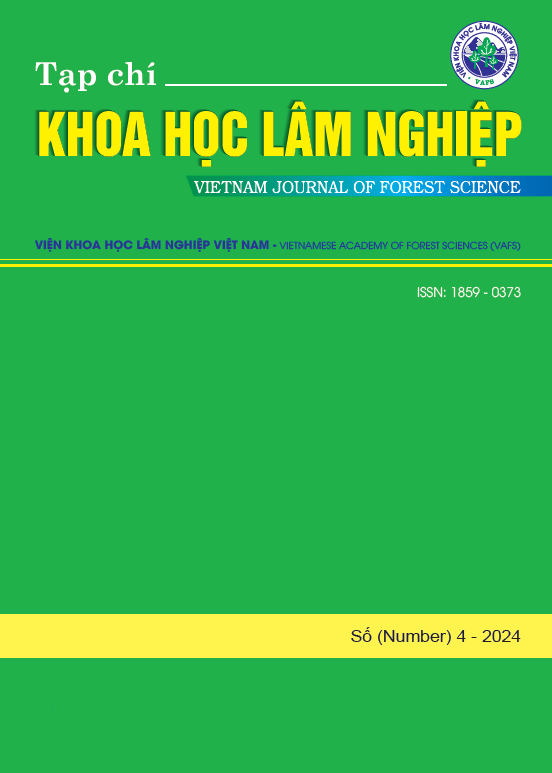THE DISTRIBUTION STATUS AND SILVICULTURAL CHARACTERISTICS OF Xylia xylocarpa (Roxb.) Taub. SPECIES IN SOME PROVINCES IN THE SOUTH CENTRAL REGION
DOI:
https://doi.org/10.70169/VJFS.961Keywords:
Xylia xylocarpa (Roxb.) Taub, distribution, silvicultural characteristics, South CentralAbstract
Xylia xylocarpa (Roxb.) Taub. belongs to Fabaceae family, this is a rare and precious tree species with hard, strong wood, distinct sapwood and heartwood, light yellowish - white sapwood, thick, dark red heartwood with slightly grained, very smooth, heavy and is in Group II according to TCVN 12919 - 2 in 2019. The article provides scientific information on the current distribution status and some forestry characteristics of Xylia xylocarpa trees in 03 provinces (Ninh Thuan, Binh Thuan and Khanh Hoa) in the South Central region of Vietnam. The results of line surveys (09 lines) and standard plots (06 OTCs 2.500 m2) show that Xylia xylocarpa trees are naturally distributed in areas with altitudes from 68 - 628 m. The highest density of the tall tree layer of the forest ranged from 48 - 54 trees/OTC (in Binh Thuan and Ninh Thuan), the highest forest volume reached 51.1 m3/OTC (in Binh Thuan). The tree density reached 11 trees/OTC in Binh Thuan and all participated in the composition formula of each OTC, the composition coefficient (IVI%) ranged from 9.6 - 209%. The adjacent tree layer had a fairly high density of 29 - 32 trees/OTC, the diameter index of the forest ranged from 3.6 cm to 3.8 cm, the height index from 3.0 m to 3.3 m. For the adjacent of Xylia xylocarpa trees, Khanh Hoa province had a large number, ranging from 6 - 8 trees/OTC. The density of regenerated trees in the forest ranged from 26 - 47 trees/OTC, with 10 - 13 regenerated tree species. The number of regenerated trees of Xylia xylocarpa trees ranges from 4 to 9 trees/OTC and all are involved in the formula for regenerating trees. Xylia xylocarpa trees mainly regenerates seeds but the ability to regenerate shoots of Xylia xylocarpa trees also has a high rate, this trees are mainly of good quality and at a height level of less than 50 cm.
References
Nguyễn Tiến Bân (chủ biên), 2003; 2005. Danh lục các loài thực vật Việt Nam. NXB Nông nghiệp, Hà Nội.
Bộ Nông nghiệp và Phát triển nông thôn, 2018. Thông tư số 33/2018/TT-BNNPTNT ngày 16 tháng 11 năm 2018, về Quy định về điều tra, kiểm kê và theo dõi diễn biến rừng.
Bộ Khoa học và Công nghệ, 2019. Tiêu chuẩn Việt Nam (TCVN) 12619 - 2: 2019 Gỗ - Phân loại - Phần 2: Theo tính chất vật lý và cơ học.
Daniel Marmillod, 1982. Methodology and results of studies on the composition and structure of a terrace forest in Amazonia. Doctorate. Georg - August - Universität Göttingen., Göttingen.
Nguyễn Đình Hưng, 2009. Át lát cấu tạo tính chất gỗ và tre Việt Nam, Tập 1. NXB Nông nghiệp. 54 tr.
Lâm Thị Mỹ Linh, 2017. Một số hợp chất Polyphenol được phân lập từ thân cây Chiêu liêu cườm (Xylia xylocarpa). Tạp chí Khoa học Trường Đại học An Giang. Số 18 (6), 69 - 78.
Vương Hữu Nhi, 2002. Bước đầu tìm hiểu một số đặc điểm sinh thái và khả năng gây trồng loài Căm xe (Xylia xylocarpa) ở các tỉnh phía Nam, Thông tin Khoa học Kỹ thuật Lâm nghiệp số 1/2002, Viện Khoa học Lâm nghiệp Việt Nam.
Nguyễn Tích và Trần Hợp, 1971. Tên cây rừng Việt Nam. NXB Nông thôn, Hà Nội. 258 trang.
Nguyễn Nghĩa Thìn, 1997. Cẩm nang nghiên cứu đa dạng sinh vật. NXB Nông nghiệp, Hà Nội, 223 trang.
Nguyễn Nghĩa Thìn, 2007. Các phương pháp nghiên cứu thực vật. NXB ĐHQG Hà Nội. 171 trang.
Thái Văn Trừng, 1970. Thảm thực vật rừng Việt Nam, NXB Khoa học và Kỹ thuật, Hà Nội.
Thái Văn Trừng, 1978. Thảm thực vật rừng Việt Nam. NXB Khoa học và Kỹ thuật, Hà Nội.









